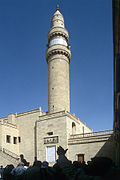| Building | Image | District/Quarter | Denomination | First built | Period | Notes |
|---|
| Umayyad Mosque of Mosul |  | Old City of Mosul | Sunni | Est. 637 | Rashidun | Considered to be the oldest mosque to be established in Mosul, left for decay for many periods until it was demolished in 1810 and rebuilt, After an extensive damage in 2017 it was renovated and reopened in 2024 |
| Great Mosque of Al-Nuri |  | Old City of Mosul | Sunni | 1172–1173 | Zengid | First built by Nur al-Din Zangi in 1172–1173. It is best known for its leaning minaret, known as "Al-Hadba" (the hunchback). The prayer hall was rebuilt in the mid 20th century, between 1940 and 1950. Destroyed in 2017 during the Battle of Mosul and was undergoing an extensive restoration process before its reopening in November 2024. |
| Al-Nabi Yunus Mosque |  | An Nabi Yunus | Sunni | 1365 | Seljuk | Built over an old Assyrian Christian church. It is believed to contain the remains of Jonah. Demolished in 2014 by the Islamic State of Iraq and the Levant. |
| Al-Nabi Jirjis Mosque |  | Old City of Mosul | Sunni | 1393 | Timurid | Construction was ordered by Tamerlane in 1393. Contains a tomb believed to be that of Saint George. Features two prayer halls for the Shafi'i and Hanafi adherents. Demolished in 2014 by the Islamic State of Iraq and the Levant. |
| Al-Nabi Shith Mosque |  | Ar Rafidayn | Sunni | 1815 | Ottoman | Believed to contain the tomb of Seth, son of Adam. Formerly part of a large cemetery and surrounded by mausoleums which are not present anymore. A completely new structure was built between the 1970s to 1980s. Demolished in 2014 by the Islamic State of Iraq and the Levant but undergoing reconstruction. |
| Imam al-Baher Mosque |  | Mahallat al-Imam al-Bahir | Sunni | 1259 | Zengid | Built in the Zengid era by Badr al-Din Lu'lu. Entombs the remains of Imam al-Bahir, a descendant of Muhammad. Demolished in 2014 by the Islamic State of Iraq and the Levant, but was reconstructed in 2022. |
| Mausoleum of Yahya Abu al-Qasim |  | Shafaa | Sunni | 1239 | Zengid | Built in the Zengid era by Badr al-Din Lu'lu. Entombs the remains of Yahya Abu al-Qasim ibn Hasan, a descendant of Muhammad. Demolished in 2014 by the Islamic State of Iraq and the Levant. |
| Al-Imam Muhsin Mosque |  | Shafaa | Sunni | 12th century | Seljuk (mosque and madrasah), Zengid (shrine) | Formerly a mosque and madrasah complex built during the Seljuk era, the madrasah was converted into a shrine for Muhsin ibn Ali by Badr al-Din Lu'lu in the Zengid era. Demolished in 2017 by Iraqi airstrikes during the Battle of Mosul. [1] |
| Mausoleum of Imam Awn Al-Din |  | Bab at-Tub | Sunni | 1248 | Zengid | Built by Badr al-Din Lu'lu, the structure survived the Mongol invasions of the 13th century. It entombs the remains of Awn al-Din ibn Hasan. Demolished in 2014 by the Islamic State of Iraq and the Levant. [2] [3] |
| Hamu al-Qadu Mosque |  | Al Midan | Sunni | 1881 | Ottoman | Built in the Ottoman era by Abdullah Chalabi, a wealthy merchant. Contains the tomb of Ala al-Din, who is a descendant of Abdul Qadir al-Jilani. Demolished in 2014 by the Islamic State of Iraq and the Levant. [4] [5] |
| Shrine of Shaykh Fathi al-Mawsili |  | Bab Sinjar | Sufi | | | A religious complex, it includes a mosque as well as the tomb of Al-Fath al-Mawsili, a revered ascetic who lived in Mosul. |













